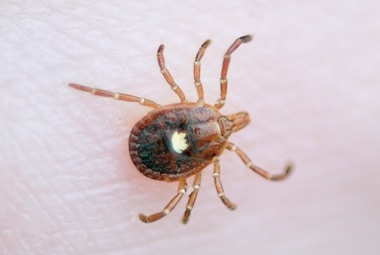
The lone star tick is named because of a well-defined white star that is located on the back of the adult female’s back. This tick is responsible for more attacks on people then other tick located in similar areas. Lone star ticks are found in Western Texas going north to Northern Missouri and east from Maine to the southern tip of Florida.
| Pest Identification | |
|---|---|
| Recognition | Before a blood meal the lone star tick is reddish-brown in color and about 1/6th-1/4 of an inch in length. After they feed and become engorged they turn slate-gray in color and grow to be about ½ an inch in length. Males are smaller than females. Adults have an oval flattened shape to their body. Larvae have 6 legs, while the nymphs and adults have 8 legs. |
| Biology | Lone star ticks produce one new generation each year. They are considered to be a ‘three host tick’, which means that each stage; larvae, nymph, and adult will all feed on a different host. Larvae and nymphs like to feed on the blood of birds, rodents, squirrels, rabbits, and raccoons. Adult lone star ticks prefer to feed on larger animals like foxes, cattle, white-tailed deer, and dogs. All three stages of lone star ticks will feed on people. This species of tick also enters into a non-feeding stage from mid to late summer that is brought on by the decrease in daylight . Each female produces 3,000-8,000 eggs that are placed under leaves and soil in the mid to late spring. The eggs will incubate for about 30 days and then the larvae will hatch and find and feed on a host for 3 to 7 days. The larvae will then drop from the host onto the ground and shed their skins 9-27 days later. Nymphs then emerge and attach themselves to another host and feed for up to 38 days. After detaching from their host they take a rest for 13-46 days before shedding their skins and becoming adults. The adults attach themselves to a third host and feed for up to 24 days and detach and lay their eggs 7-16 days after their last blood meal. While not known to transmit Lyme disease, lone star ticks are known carry a variety of diseases that can be transmitted to people including: -Tularemia -Rocky Mountain fever -Ehrlichiosis |
| Habits | Lone star ticks are found in wooded areas and in areas of overgrown vegetation, these ticks cannot survive being in areas of prolonged sunlight. Like other tick species they are also commonly found in and around the dens and nests of their animal hosts. Lone star nymphs can move very quickly and can cover the span of a person’s arm or leg in about 5 minutes. Their quick speed is a key identifying factor for this species. |
| Prevention | Prevent ticks by altering the environment to make it less appealing to them and their hosts. By protecting yourself from ticks, and by implementing a professional tick control program you can start to control your exposure to them. Environmental control. Here are a few ways things you can easily do to cut back on the amount of ticks in your yard: -Keep grass on your property cut very low, especially around fences, sheds, garages, and trees. -Remove piles of leaves, sticks and other organic debris that can conceal them. -Remove all sources of standing water that may attract them and other insects. Keep host animals away from your property by these implementing these few changes: -All garbage cans should have tight fitting lids on them at all times. -Do not feed birds. -Install chimney caps, attic vent screens and any preventative measures needed to stop rodents and wild animals from having an easy access point into your home. Personal Protection. Following are a few common ways to protect yourself and your loved ones. -Use insect repellants when spending time outside, especially in wooded areas. -Make sure to wear long sleeves and long pants that are tucked in boots while outside. -Wear light colored clothing and check yourself, children and pets before coming inside from the outside. -Treat your pets under the guidance of a veterinarian with tick preventative. |
| Professional | A Rottler technician will inspect your property and treat the exterior perimeter of the structure or the entire property with an appropriately labeled residual pesticide if ticks are present. Rottler technicians may also perform an exterior perimeter rodent control program to reduce the host populations for the Lone Star tick. |

